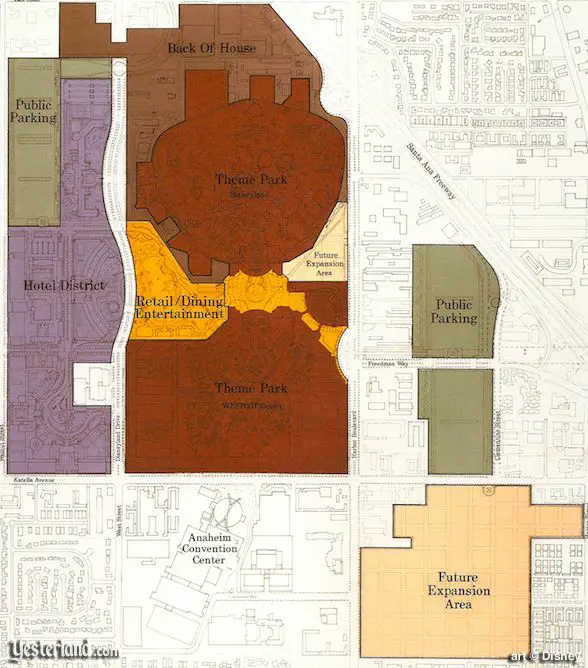Disney-Universal Fanboy
Active Member
Liberty Street

“Throughout the centuries there were men who took first steps down new roads armed with nothing but their own vision.”
- Ayn Rand
Despite the blessing of size, the first few decades at Disneyland saw new additions that packed the Park to its gills. As it had no precedent before it, Disneyland was a learning experience. A series of ideas and designs have come and gone, some more successful than others. Many of these elements remain today.
Walt Disney once said, “Disneyland will never be completed as long as there is imagination left in the world.” Through the years, Walt himself would provide sneak previews of new additions to Disneyland on television and in print. The early success of Disneyland meant that his Magic Kingdom would need more capacity and fast. In an effort to ease traffic through Main Street, it was decided early on that the first new “land” at Disneyland would follow along Main Street’s eastern half with an entrance from the Town Square. A street in celebration of early America and its independence began development after a number of ideas were discussed, an obvious choice for a thematic extension of Main Street, U.S.A.
“As you know, Disneyland Park is a sort of a monument to the American way of life. But after reading ‘Johnny Tremain,’” Walt said to his audience, “we realized we had overlooked one major item in the blueprint - a memorial to the freedoms that made it all possible. Well, we're busy putting it in, right here off the Town Square. We're calling it 'Liberty Street.' Everything is in the planning stage, of course. But our research has taken us back to a period we like to recreate as a reminder that the liberty story is a story without end. In fact, Liberty Street will be Johnny Tremain's Boston of about 1775.”
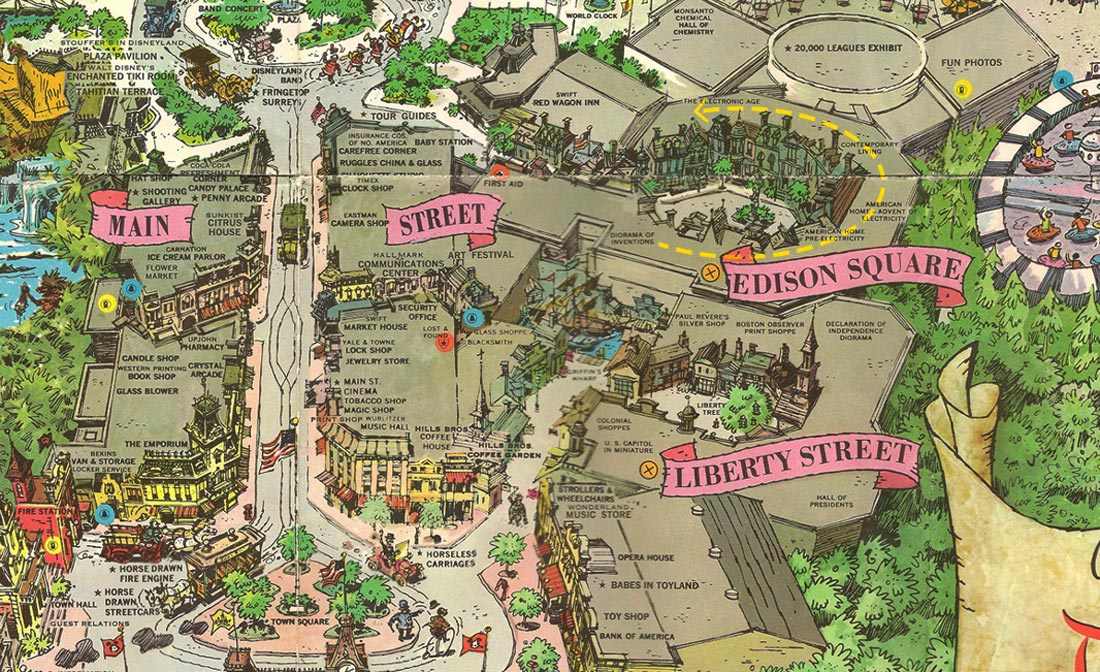
In the two years it took building and conceptualizing Liberty Street, Imagineering devised an entirely separate offshoot behind Main Street and north of Liberty Street. Edison Square would tell the story of the way in which one invention by Thomas A. Edison influenced the growth and development of America and the world. “Harnessing the Lightning” would showcase the American family and how they felt the impact of electricity across four generations. Budget, however, scrapped the Square, and Liberty Street, also devised as a Square, became a straight thoroughfare to the Central Plaza.
When Walt announced Liberty Street in 1956, he excitedly discussed an elaborate attraction called “One Nation Under God.’’ The attraction would tell the dramatic story of our young republic before finishing with a visit to The Hall of Presidents. “The Circarama for the ‘One Nation Under God’ showing will have a 200-degree screen,” Robert de Roos wrote. “After the Circarama showing, a curtain will close, then open again to reveal the Hall of Presidents. The visitor will see all the Chief Executives modeled life-size. He’ll think it’s a waxworks—until Lincoln stands up and begins to talk.”
The attraction featured an impressive gathering of every President of the United States (up to that time) - from Washington to Eisenhower - lifelike and animated. Such animated figures, however, were not possible in 1958. So instead, Liberty Street opened with The Hall of the Declaration of Independence.
Housed inside a version of Independence Hall called Liberty Hall, visitors watched as paintings of the American Revolution were shone upon with spotlights and described by dull narration. The showcase ended in a viewing of the Declaration of Independence itself (a copy). A sign assured visitors that this was just a placeholder for future improvements, and that within a few years time, One Nation Under God and The Hall of Presidents would open in 1963. This would never happen. The Hall of Presidents was finally realized at Walt Disney World after fifteen years of development in their own version of Liberty Street: Liberty Square. But never at Disneyland.
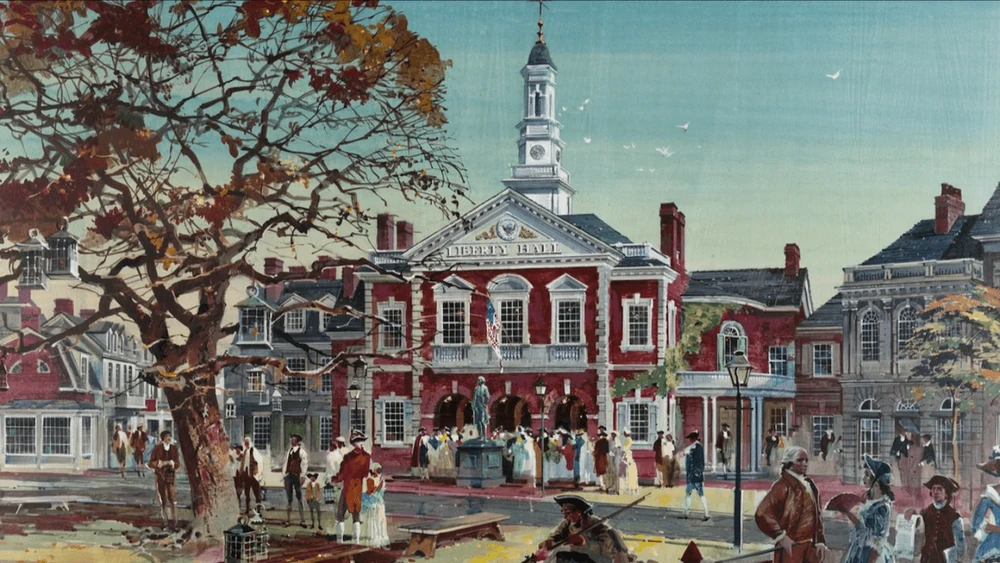
One Nation Under God directly influenced the toast of the 1964 - 1965 New York World’s Fair: Great Moments with Mr. Lincoln. Despite the attraction having more than enough theming to match Liberty Street, Walt chose the intimate Main Street Opera House so that guests could easily find the attraction they had heard such buzz about from the East Coast. He had other things in mind for Liberty Street.
Rather than building Edison Square for the Carousel of Progress, Walt selected Liberty Street as the home for his typical American family enjoying the advent of electricity and the other advances of the American industry through the 20th Century. While some would argue Tomorrowland a more suitable location (or even the Opera House), the Hall of the Declaration of Independence had long overstayed its welcome and held a large footprint. The innovative Carousel Theater, a combination theatrical venue and rotating ride system, was built affixed to Liberty Hall, the latter now the entrance to this musical journey through the science and advancements made possible by the American Dream.
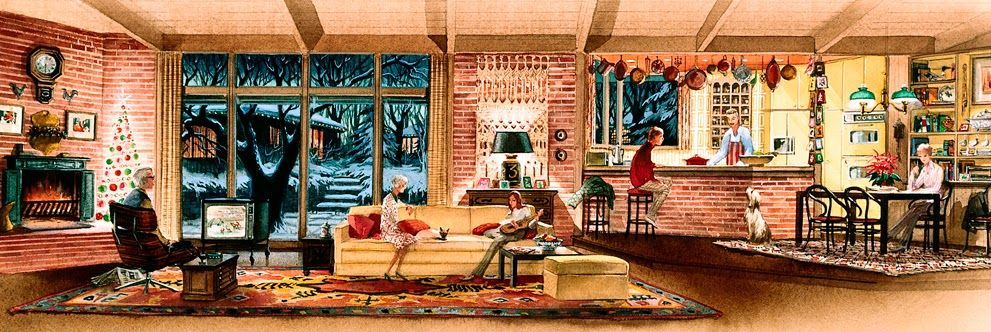
The original show building was demolished in late 1966. The Carousel Theater opened on July 2, 1967, and was brilliantly concealed behind Liberty Hall. No one would ever expect that the theater “inside of” the newly reopened Liberty Hall would rotate a full 360°.
The unbuilt Harnessing the Lightning laid the groundwork for the beloved Carousel of Progress, which also premiered at the 1964 - 1965 New York World’s Fair. Its sponsor, General Electric, turned Liberty Hall’s museum-like lobby into an exhibition for their latest products and ideas. The star of the exhibit was the animated, three-dimensional model of “Progress City,” an early predecessor to Walt Disney’s EPCOT. This model remains intact today, showcased now in Tomorrowland.
The Carousel of Progress lasted six years at Disneyland. Its final guest left humming Richard and Robert Sherman’s “There’s a Great Big Beautiful Tomorrow” on September 9, 1973. The show moved to Walt Disney World the following year, once again leaving Liberty Hall and Liberty Street without an attraction.
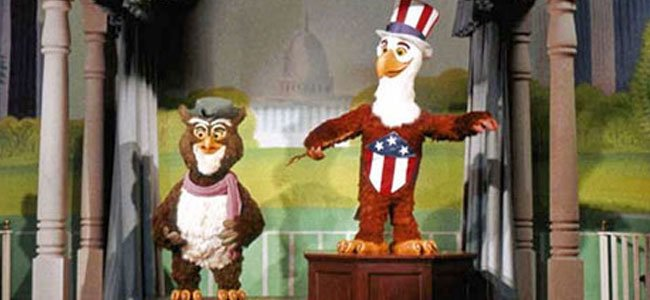
When Liberty Square debuted at Walt Disney World in 1971, it quickly became the most popular area in the Magic Kingdom. This might have had something to do with the upcoming American Bicentennial in 1976, which commenced officially in 1975. Liberty Street at Disneyland enjoyed the same decade-long popularity and enthusiasm with the arrival of America Sings on June 29, 1974.
The public reaction to America Sings was the result of undiluted and absolute Marc Davis Imagineering. A salute to the Great American Songbook, America Sings gave the Carousel Theater and Liberty Hall complex a second lease on life. A fun-loving look at our musical heritage, the attraction’s theme song “Yankee Doodle” carried across the introduction to several acts: Going South - Heading West - The Gay Nineties - Modern Times. Sam the Eagle (voiced by Burl Ives) and Ollie (an owl), led the all Audio-Animatronics cast of 100+ critters through a tuneful tour of popular music, featuring such American institutions as “Bill Bailey Won’t You Please Come Home?” and “Down by the Riverside.”
The former General Electric exhibit in the Liberty Hall lobby was turned into an exhibition on the history of music and dance in the United States. The Progress City model was replaced by a pre-show featuring Audio-Animatronics figures of Henry from the recently opened Country Bear Jamboree and Jose from the Enchanted Tiki Room talking about the new musical act guests were about to see in America Sings.
Following two years in development, “the first Disneyland ‘mega-musical’” was considered exemplary and the purest representation of Marc Davis’ unique eye for anatomy, caricature, animation, staging, and humor. Using the same revolving carousel technology as its predecessor, hundreds of musical cues and moving set pieces, America Sings presented more programming, timing, and technical challenges than any other attraction to that date. The attraction introduced clever theatrical techniques to make the animal performers appear onstage, such as having characters rise up into view on one side of the stage while lighting directed the viewer's attention elsewhere.
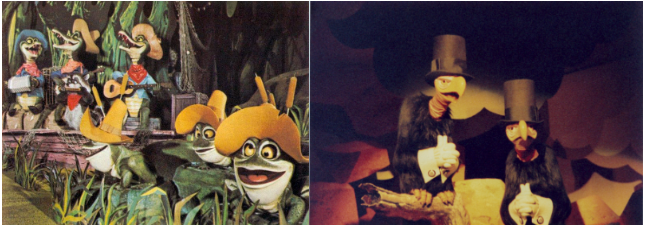
Once the Bicentennial was over, interest dwindled in America Sings. Liberty Street overall became more of an alternate Main Street when the Main Street Electrical Parade began its second run in 1977. Guests walked right past America Sings in their efforts to bypass the crowds on Main Street.
In 1983, Imagineer Tony Baxter dreamt of a water flume ride that would require a whole menagerie of critters to fill its colorful cast. Nearly a hundred of the various animal figures seen in this attraction were relocated from America Sings when it lowered the curtain for the last time on April 10, 1988. Two geese were removed from the attraction and “skinned” to become droids in the queue to Star Tours, opening at Disney-Universal Studios in 1990. The majority of the remaining cast found a new home in Tony Baxter’s aforementioned flume ride; but we’ll tell that chapter of the Disneyland story another time. Liberty Street was once again without a headlining attraction.

The Carousel Theater was demolished in 1989. Liberty Hall received extensive remodeling inside and out. A new theater was built from the ground-up, one that did not rotate, but had plenty of technological achievements to claim. The lobby became the American Heritage Gallery, a stunning rotunda and collection of corridors filled with engaging exhibits on various aspects of American culture and history. The Smithsonian-caliber exhibits highlight the rich histories and cultures of Indigenous Americans, African Americans, and classic Americana. The walls contain quotes from iconic Americans, and paintings of historic events and achievements across the United States’ storied history.
The American Adventure, an attraction that has anchored EPCOT’s World Showcase since 1982, filled the vacant new theater at Liberty Hall. The ideal attraction for Liberty Street and an obvious successor to America Sings (and Mr. Lincoln), The American Adventure was built in record time, opening on July 17, 1990, Disneyland’s 35th Anniversary. A feat of entertainment and engineering, ten different sets are stored under the stage and are moved forward and backward on cue by groundbreaking stagecraft and computer-based technology.
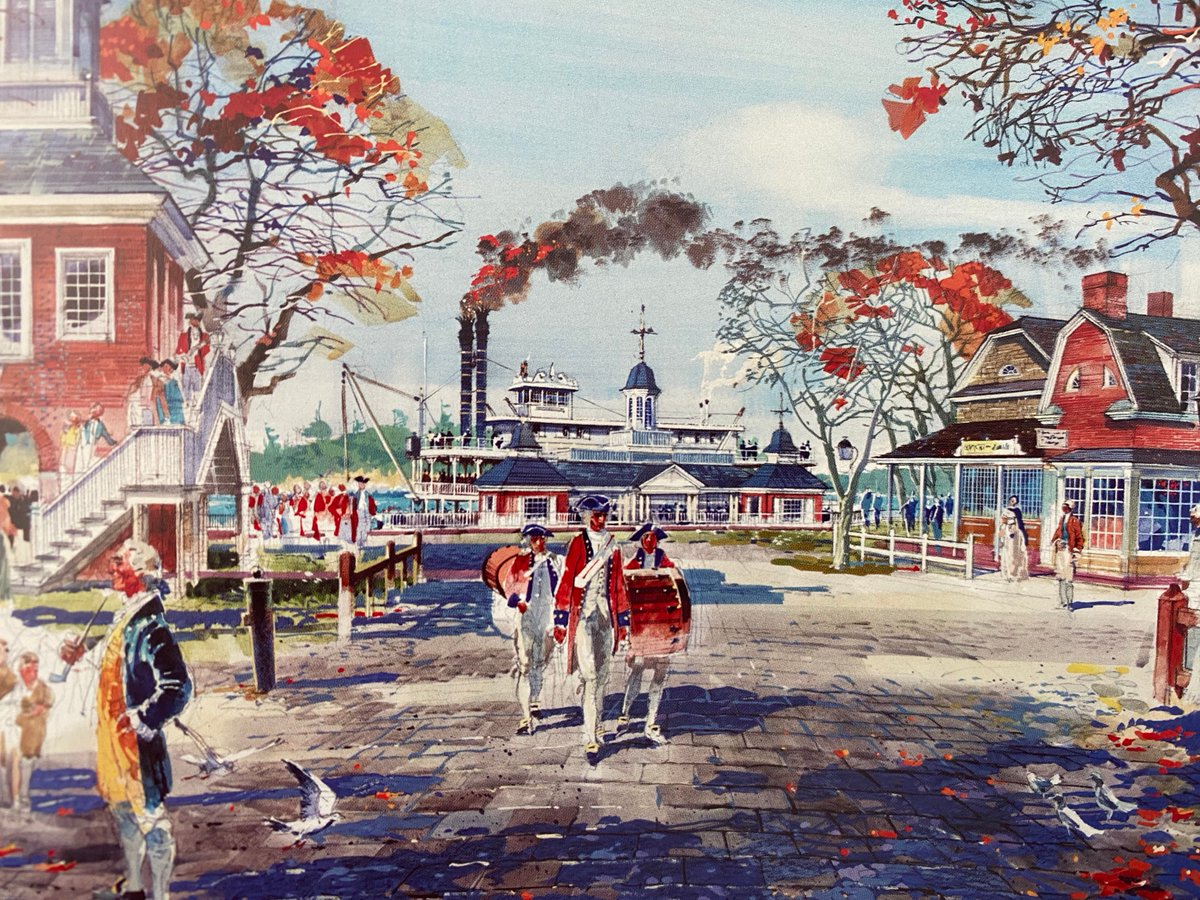
A hallmark of The American Adventure is its stirring and unforgettable theme song, “Golden Dream.” The song underscores a grand finale montage filled with historic moments and figures from throughout the American Dream’s countless true-life adventures and achievements. Robert Moline and Randy Bright wrote the song specifically for the attraction, but today, it has become an unofficial anthem for Liberty Street, too. Great Moments with Mr. Lincoln was given a unique dual-exit to accommodate the new attraction up the street. One exit corridor leads into Town Square, the other, decorated with the flags of all 50 States, leads directly into the lobby of Liberty Hall, forever uniting The American Adventure with its humble inspiration: Great Moments with Mr. Lincoln. One could consider Great Moments a “preshow” to the stirring panorama of American history shown at The American Adventure, always nostalgic, always optimistic.
Main Street, U.S.A. has vanished. The gas lamps and hitching posts are now candlelight and lanterns’ glow. The shutters on each building are hung by leather straps - metal hinges were melted down and turned into ammunition by soldiers. The gatehouse-entrance from Town Square has two lanterns in the highest window. These signal the advance of the British to Paul Revere - “one if by land, two if by sea.”
Liberty Street is as A Portrait of Walt Disney World described Liberty Square in Orlando, “a panorama of times (pre- and post-American Revolution), locales, and architectural styles - that range from the Dutch New Amsterdam designs of New York, to the Georgian style of Virginia, the Federal influences of Philadelphia, and to the New England character of Massachusetts. Although visitors to the area may not be fully aware of it, their senses encounter a layering of detail that fully informs their experience, providing touch points of authenticity and triggering a nostalgia for an era they never experienced but are aware of from educational and entertainment sources.”
The town is filled with merchants and trades in reflection of the era. A flag for each of the 13 Colonies lines either side of the main thoroughfare. Both the Liberty Tree and Liberty Bell are replicated here. In fact, the mold for the Liberty Bell was taken from the real thing in Philadelphia. Disneyland was the first ever to copy the mold, and has proudly displayed its own Liberty Bell since the land opened in 1958.
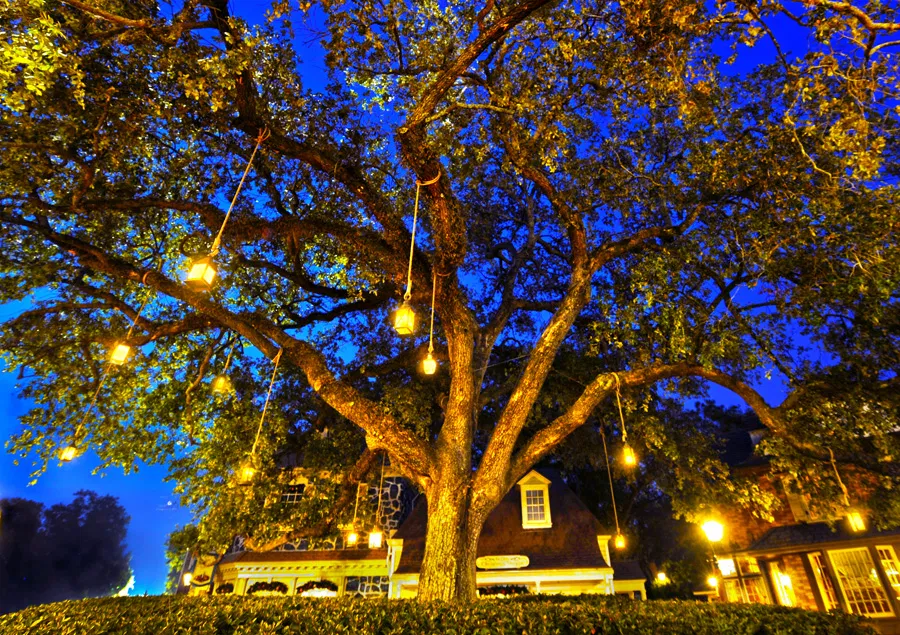
"The original Liberty Tree, a stately elm, was a rallying point for pre-revolutionary activities. The open space under its branches was called 'Liberty Hall' and a flag pole was erected through its branches with a hoisted flag, the symbol for action. Countless inflammatory cartoons and verses were nailed to its trunk and many Tories hung in effigy from its branches. Perhaps its proudest moment was the repeal of the Stamp Act when innumerable lanterns blazed among its branches for all to see."
- A Sign Near the Liberty Tree
The impressive live oak that makes the Liberty Tree was transported to Disneyland amidst construction in 1957. Walt himself was on hand to select and relocate the proud tree. The tree is well over two centuries old and is a worthy tribute to the real Liberty Tree in Boston. Historically, the real tree was a beacon for the American Revolution. Those rallied against the oppression of the British Empire would gather here in protest or plotting. As such, one lantern for each of the original American colonies hangs from the tree.
One of our first stops is the New England Print Shop which began editing Disneyland's still popular newspaper, The Disneyland News, in 1958. The newspaper can be purchased here (for $1), as well as at the Newsstands in Town Square. The proprietor uses a Washington hand press like the one Ben Franklin used more than 200 years before. Samuel Osgood, Postmaster General was at first a false facade with a replica post office inside. Walt soon took to the idea of having an operational United States Post Office at Disneyland. Since 1961, "Samuel Osgood'' has serviced the mailboxes found throughout the Disneyland Resort, and still processes resort and personal mail today. Colonial Mercantile is similar to your run-of-the-mill “country store.” The merchandise and décor specializes in stuffed toys, kitchenware, clothing, hats, and “vintage” signs reminiscent of the Old South and Midwest.
Liberty Street’s pavement is red, but a brownish-gray stripe runs right down the middle. This streak interestingly travels to or from the only restroom facility on Liberty Street. Indoor plumbing did not exist in the colonies, so our forefathers simply tossed their waste out the windows, and, well, you get it.
The Blacksmith Shop has a skilled metalsmith who creates grills, railings, lamps, and horseshoes, also the location responsible for shoeing the horses that travel Main Street, U.S.A. every day. Paul Revere’s Silver Shop has a silversmith who crafts all the available wares in-store, while Ye Olde Antique Shoppe is filled with authentic antiquities and collectibles from across the United States’ history. Crates of tea from Boston Harbor are among the details outside this one-of-a-kind antiques retailer.
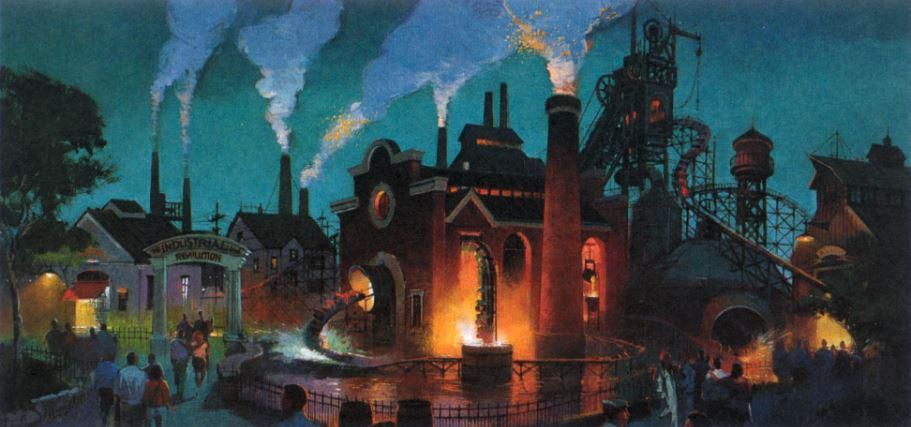
In 1990, amidst the opening of Disney-Universal Studios, The American Adventure, and the ongoing construction for Disneyland Paris, Michael Eisner visited Colonial Williamsburg in Virginia. This visit inspired in him a passion for a new East Coast Disneyland. Only it wouldn’t be a Disneyland.
Disney’s America was the pitch, and 3,000 acres outside Haymarket, Virginia was the setting. A 40 mile excursion from Washington, D.C. would bring visitors from around the world to the gates of what Vice President of Disney Bob Weis called “Not a Pollyanna view of America. We want to make you a Civil War soldier. We want to make you feel what it was like to be a slave or what it was like to escape through the Underground Railroad.”
Called a “commercial blitzkrieg” by protesters and historians alike, Disney’s America never made it off the page. Direct competition with existing historical attractions, overwhelming demands on the roads and freeway infrastructures, and perhaps the idea of having a park without Disney characters or familiar IPs were the nails in its coffin. Even an idea to purchase Knott’s Berry Farm in Buena Park, California, six miles northwest from Disneyland, fell by the wayside. Disney’s America was never built.
In the late ‘90s, Eisner requested the addition of a thrill ride to Main Street, U.S.A. or Liberty Street, either or, and to preferably “dig up” an idea from the Disney’s America project. The Imagineers knew that neither land really needed the thrill, nor the extra capacity, but the addition of a thrill ride to Liberty Street wouldn’t hurt attendance at The American Adventure. When the Liberty Street location was chosen, Imagineers chose the real estate once occupied by a large picnic area and a matte painting of Griffin’s Wharf.
The first idea wasn’t from Disney’s America at all, but was for a coaster-dark ride themed to the latter segment of The Adventures of Ichabod & Mr. Toad. The would-be attraction would have had guests aboard hollowed-out pumpkins spinning 360° through the banked curves and slopes of a haunted forest, chased by the cackling Headless Horseman. This, of course, would have been costly to build given the attraction’s need for multiple Ichabod Crane and Headless Horseman Audio-Animatronics. Eisner pushed for something from Disney’s America. “How about that Industrial Revolution ride?”
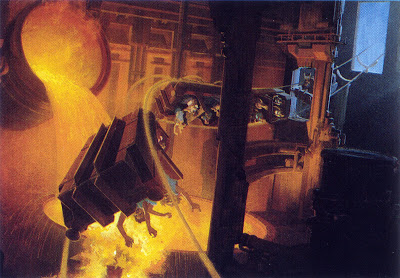
Although not entirely appropriate to the 1770s-set Liberty Street, the historic Industrial Revolution began in 1760 and ended between 1820 and 1840. The Industrial Revolution changed the American way of life in every way, and is considered as significant to historians as the domestication of animals and plants. The first Industrial Revolution in the United States occurred during the latter half of the 18th Century (when Liberty Street is set), and the second occurred following the Civil War, almost a century after the first.
Best of all, Eisner loved The Industrial Revolution “E-Ticket.” The idea was a favorite of his from the Disney’s America project. Eisner had a lifelong love for factories and assembly lines as documented in his autobiography Work in Progress: “Watching as razor blades were being manufactured in my grandfather’s factory during my youth mesmerized me. For some reason, I’ve always found drama in assembly lines - the excitement of watching products take shape.”
Intended for an area of Disney’s America called “Enterprise,” The Industrial Revolution is a coaster-dark ride hybrid quite unlike Space Mountain in neighboring Tomorrowland. Housed within a New England factory of tall smokestacks and a waterwheel affixed to the calm waters of a reflecting lagoon, we board a minecart and travel inside and out of the historic facade. The steel coaster looks into miniature dioramas and to-scale mechanisms and machines in action. The looping coaster was the first of its kind at the Disneyland Resort and set the precedent for future thrill-seeking attractions to come.
The Industrial Revolution celebrated Liberty Street’s 40th Anniversary when it debuted on July 4, 1998.
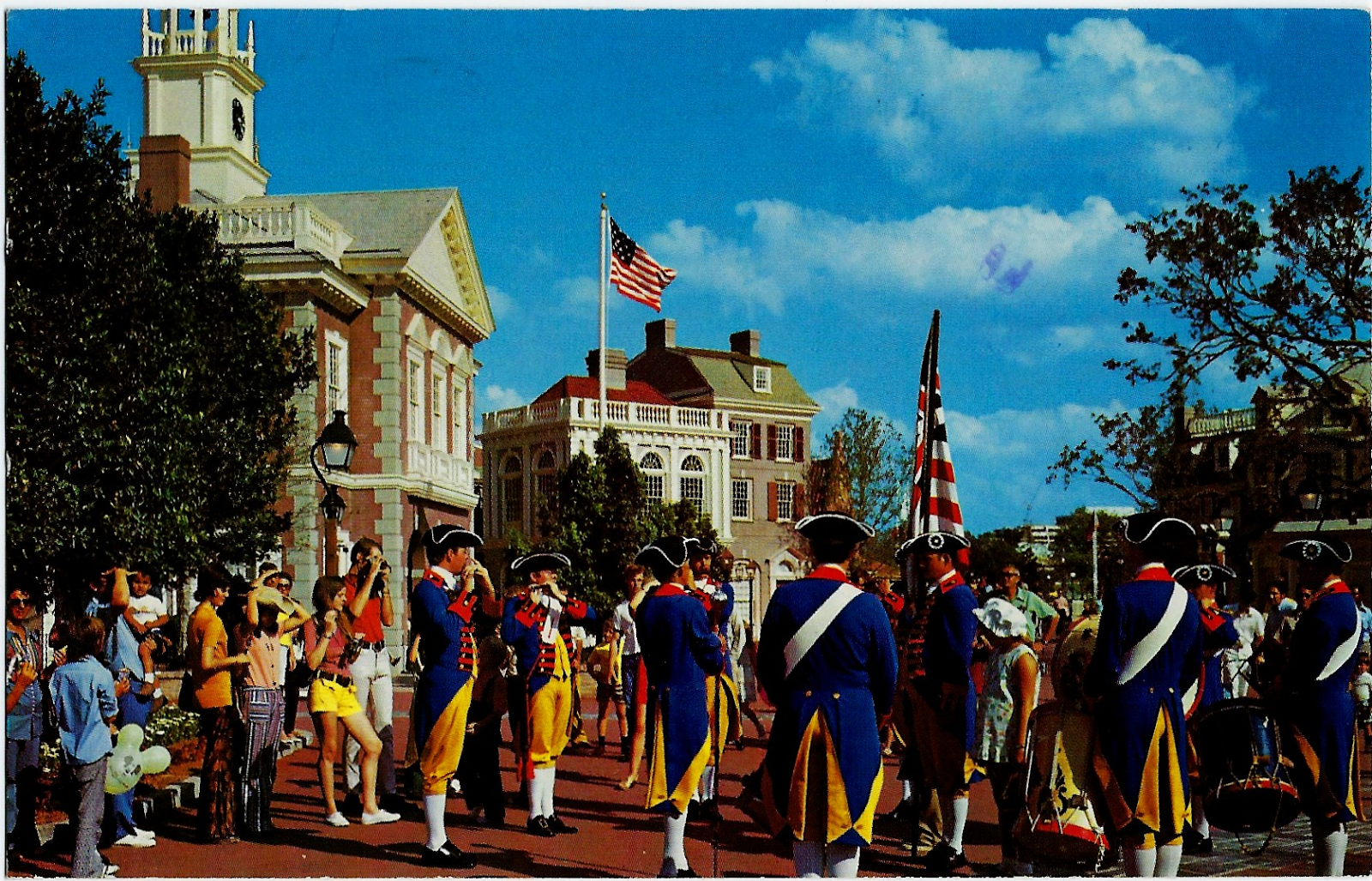
"Liberty Street presents a more serious side of our heritage. Perhaps the greatest dream to ever fire the imagination was the dream of a new nation founded in freedom. The birthplace of this dream is recreated on our Liberty Street. Here is a vision of colonial life as seen by Paul Revere, Patrick Henry, and Benjamin Franklin. Here, patriots have assembled to reaffirm their faith in liberty and justice for all."
Venerable entertainment since 1958, the Fife & Drum Corps recollect the spirit and celebration of the American Dream. The musicians, clad in the uniform of Revolutionary America, have been integral throughout Disneyland's history of live entertainment. Conceived as a salute and celebration honoring the American Bicentennial, "America on Parade" began its daily performances down Main Street in 1975 at both Disneyland and Walt Disney World, and continued until September of 1976. The Fife & Drum Corps led the beloved America on Parade, and have performed in the "encore" for the Main Street Electrical Parade since July 4, 1976: "To Honor America."
Although a ride-through attraction based on The Legend of Sleepy Hollow was never built, Sleepy Hollow Tavern is a barroom befitting of both our inner patriot and our inner grim, grinning ghost.
The menu is in celebration of all things Americana, from smoked turkey legs and cheeseburgers to pumpkin pie and New England clam chowder. This stately colonial home is Liberty Street's original dining hall. The tavern itself is a replica of Baltus van Tassel’s farmhouse seen in The Adventures of Ichabod and Mr. Toad. A weird portrait of the Headless Horseman hangs above the fireplace, and - did that portrait just cackle? A sign indicates an upstairs establishment: “MUSIC & VOICE LESSONS - BY APPOINTMENT - ICHABOD CRANE, INSTRUCTOR.”
When Disney-Universal Studios began its Halloween Horror Nights event in 1991 as a 3-night event, Imagineers began dreaming of ways to counter the more adult-oriented event within Disneyland itself. Although it took years to hit the ground running, a seasonal walk-through attraction, The Revenge of the Headless Horseman was introduced for the October season in 2011. It has since become a staple of the Halloween offerings and has been updated each season since, serving as Disneyland’s “adult labyrinth.”
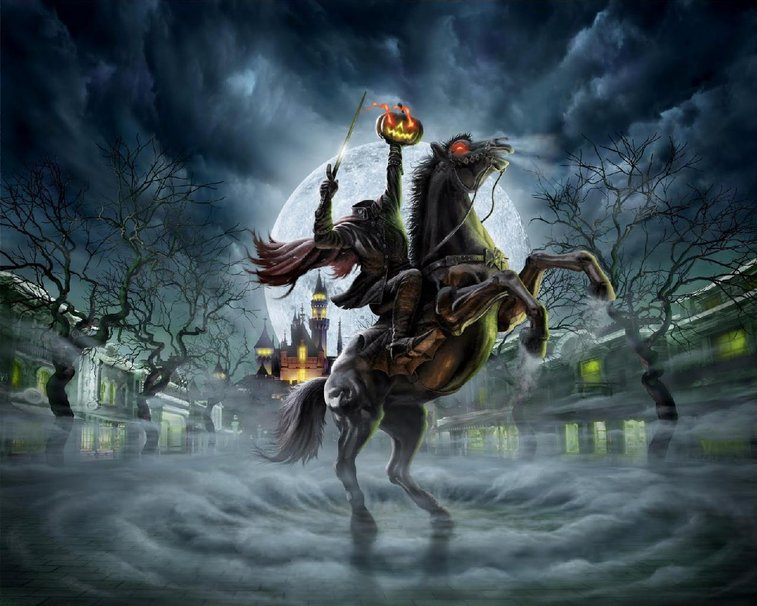
The walk-through (which also ran out of Hong Kong Disneyland’s Adventureland from 2011 to 2014) attraction is held within an old carnival sideshow, one that mysteriously lives on the outskirts of Liberty Street, but only appears to visitors in the autumn season. Thaddeus Oswald, a disgraced member of S.E.A., has run his turn-of-the-century “Amazing Traveling Sideshow” for years now, but his latest exhibit, the supposed “Head of the Headless Horseman,” has caused more than a few technical difficulties amongst the guests and his performers… Mind thy head.
In recent years, the seasonal attraction has gone on to include a foreboding scene of decaying puppets and antique dolls, where the iconic (and chained) Pinocchio and sinister clown of Hong Kong Disneyland’s “Nightmare Experiment” walk-through steal the show. The Headless Horseman remains an integral element to the attraction, but has also gone on to represent Liberty Street and Disneyland during the Halloween season. The dreaded phantom follows Ichabod Crane at the beginning of the seasonal Parade of Screams, and even has a statue in his likeness in Town Square.
The Town Crier calls for the attention of Liberty Street citizens, gathering us before the storefronts near Liberty Hall. The Muppets - consisting of Kermit the Frog, Miss Piggy, Fozzie Bear, Sam Eagle, and The Great Gonzo - appear in the second-floor windows, bringing with them their fuzzy view of American history.
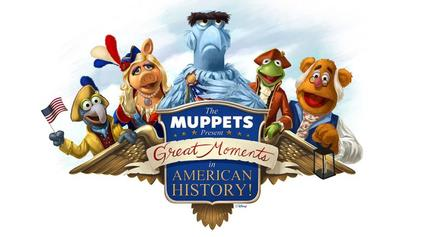
The Muppets Present...Great Moments in American History is a reverent, most sensational, inspirational, historical performance retelling the signing of the Declaration of Independence and the midnight ride of Paul Revere, told only as The Muppets can; a unique “window” into our nation’s past, if you will. The Regal Eagle Smokehouse celebrates the regions of American backyard barbecue and craft beers and ciders from around the United States and is filled to overflowing with subtle nods and details referencing The Muppets. Sam Eagle is integrated into the design of just about everything (subtly, of course), and has reference to “Sam’s Centennial Cook-Off - A Salute to All Cook-Offs But Mostly Barbecue.”
"What our show says is that the American adventure will always be a struggle, but if we can apply ourselves in positive ways and deal with reality, we can move forward to a better future.”
- Disney Legend & Imagineer Randy Bright
When the curtain falls on a performance of The American Adventure, there is applause, inspiration, often tears. This moving production, the dramatic thesis statement of Liberty Street, features 35 Audio-Animatronics figures, a 72-foot screen with rear-projected images, and a stirring musical score, all achieved through technological stagecraft. As put by A Portrait of Walt Disney World, “The ambitiousness of its execution is undeniable. Condensing over 390 years of history into a twenty-eight-minute presentation that inspires, awes, questions, reflects, entertains, and informs - through unprecedented technology and imagination - remains an unparalleled achievement…even for Disney!”
The American Adventure endures as the same groundbreaking triumph that took Imagineers five years to develop for its first performance at EPCOT Center in 1982. Once inside the Liberty Hall rotunda, visitors are serenaded by the Voices of Liberty. Their soaring voices fill the rotunda with outstanding beauty and purified acoustics. The American Heritage Gallery is a suited background to their exquisite vocals.
The American Adventure began with a number of sketches from Marc Davis. One of his pieces, “Men of Humor,” featuring Ben Franklin and Mark Twain, was the basis for Imagineer Randy Bright’s draft that he pitched and developed for EPCOT Center. Following the pitch, CEO Card Walker slammed his fist on the table and said, “It’s worth the price of admission to Epcot.” Today it’s even worth the price of admission to Disneyland.
***
Liberty Street (West)
1. Gatehouse Entrance (Paul Revere Lanterns)
2. Blacksmith Shop
3. Colonial Mercantile
4. Sleepy Hollow Tavern
5. Samuel Osgood, Postmaster General
6. Liberty Street Farmer's Market
*Center Street Entrance to Main Street*
*Liberty Tree in Middle of Walkway*
7. Revenge of the Headless Horseman Show Building
8. Liberty Street Parasol Cart
Liberty Street (East)
1. Liberty Bell Display (Opposite of Gatehouse)
2. Paul Revere's Silver Shop
3. Ye Olde Antique Shoppe
*The Muppets Present...
4. Liberty Hall (Featuring The American Adventure & American Heritage Gallery)
5. Regal Eagle Smokehouse
6. New England Print Shop
*Liberty Tree in Middle of Walkway*
7. The Industrial Revolution (Coaster)
I love this! Sad that Edison square gets cut due to budge, but it’s good! I love the addition of the Industrial Revolution coaster, but A few questions like I always do to annoy anyone that comes across my path:
- I understand there was probably not room for griffins wharf, but space mountain would be in the way of most of the stuff, could you make a map that shows how the land would look?
- I know you love adding the American adventure from epcot Here, but I feel like it doesn’t fit the theme of liberty street. What would be a secondary option if you excluded it?
- And as for the America sings animatronic hint, I swear, life or death is in your hands. I rather be surprised @MANEATINGWREATH so Don’t tell me yet.

